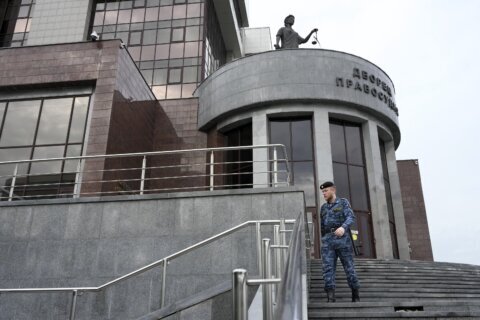NEW YORK (AP) — In a dimly lit room strung with fairy lights and ivy, transit workers file in and lie on inflated cots. Soothing piano notes play as a teacher rubs their ankles and toes, helping each with heated blankets and eye masks.
“Breathe in,” she says. “Think of a balloon, filling up with fresh energy. Your spine dropping into softness.”
The teacher, Lalita Dunbar, sprays a mist scented with lavender and lemon as she slips around the room.
“At the sound of the chime,” she says, “take a deep breath in.”
The relaxation class, held at a union hall for New York City transit employees, has emerged as one of the ways in which transportation workers around the country are trying to manage their fear and anxiety over a rise in violent crime on subways and buses. Concern has grown after a series of especially brutal attacks in recent months against bus drivers, subway operators and station agents.
Reports of crime against transit workers have been rising since the pandemic erupted in 2020, when millions of Americans suddenly avoided subways and buses for fear of contracting COVID-19. Their exodus left transit workers more isolated and vulnerable to attacks.
Yet even with many travelers having returned to subways and buses, the rate of violent assaults on transit systems has remained elevated. The level of crime is all the more striking because it coincides with a steady decline over the past three years in overall violent crime in the United States.
Nationally, the rate of reported major assaults against transit workers reached a 15-year high in 2023, up 47% from 2020, according to an Associated Press analysis of Federal Transit Administration data. And between 2011 and 2023, the rate of assaults more than quadrupled.
By contrast, reports of overall violent crime in the United States have dropped every year since 2020, FBI data shows.
“We’re in the line of fire every day,” said Blanca Acosta De Avalos, a bus driver in in Omaha, Nebraska, who was severely beaten three years ago by a man who had chased some women onto the bus. “We don’t have no protection.”
Finding ways to reduce stress for transit workers
With transit workers trying to manage their stress over the threat of violence, some unions and transit agencies are seeking ways to both reduce violence and ease anxieties.
In New York, a transit union this year began offering not only free relaxation sessions but also yoga and meditation classes. The classes were begun after a subway operator who had been looking out the window of a train at a Brooklyn station had his throat slashed in February. The victim was treated at a hospital, where he received 34 stitches and was released.
“Being a bus operator, you’re pretty much worried about everything at every moment of every day…so you don’t really get a chance to relax,” said Grace Walker, a New York City bus driver. “You’re driving a pretty big machine, and you have a lot of customers’ lives at risk.”
Walker, who attended the relaxation class, said it helped her decompress.
Transit agencies in Omaha and elsewhere are teaching de-escalation techniques to help drivers defuse potential confrontations. If a passenger makes offensive remarks, for example, the driver is coached to remain respectful and quiet. Among other steps, some unions are pushing for partitions to isolate drivers and protect them from assaults.
“My barriers are always up,” said Laticia Wright, who was driving a bus in Columbus, Ohio, last August when bullets flew through the windshield, just missing her head. “I look at people’s hands and their movements when they get on my bus.”
Wright had opened the door for some men waiting at a stop. As one of them stepped on, an SUV swerved in front of the bus, stopped, and someone inside opened fire.
Passengers dropped to the floor, shouting to Wright, “Drive!”
“I was so hurt and so upset and screaming, and I’m trying to dodge the bullets,” Wright recalled. “I can feel the pinging and the glass and what was falling on my neck, that burned my neck and my shirt.”
Wright swerved to seek some sort of shelter, shaking her arm as she drove.
“Are you OK?” a passenger yelled above the din.
“No!” she wailed.
None of the bullets struck Wright. But broken glass did. She was so traumatized that she stayed home for three weeks and spoke daily with a counselor through an employee assistance program.
“I had to really just put it behind me,” she said. “Sometimes, when I go to the area, it kind of does something to me. I kind of just go and, you know, hurry through that area.”
Nearly a year after the shooting, Wright’s doctor thinks she may have post-traumatic stress disorder. Wright recently awoke in a sweat after she heard a popping sound.
“It just took me back to that moment,” she said. “I find myself looking at every white SUV that passes by my car or my bus now. Are they going to start shooting?”
To help relax, Wright receives chair massages offered through work. But her main coping mechanism is prayer. In tense situations, she tells herself: “OK, God. Take the wheel. Calm this situation down. Calm me down.”
Problems started during the pandemic
Transit workers and officials largely blame lingering effects of the pandemic for the increased violence. After COVID-19 struck, many transit agencies let riders hop on for free. Some people who were struggling to stay housed rode buses and subways for shelter. More riders overdosed on drugs. People who had previously used mass transit to commute to work stayed home.
Even now, transit ridership nationally is only at 75% of pre-COVID levels, according to the American Public Transportation Association. As of last year, New York City’s subway ridership was at 68% of pre-pandemic levels, bus ridership at 63%, the Metropolitan Transit Authority reported.
Wright, the Columbus bus driver, says violence surged in recent years after some area mental health facilities closed and homes grew more expensive, leaving many people unable to stay housed.
A highly stressful vocation
Even in the best of circumstances, transit workers endure disproportionately high levels of anxiety and depression as well as stress-related illnesses, including heart disease and musculoskeletal disorders, according to a review of dozens of studies published in the Journal of Transport & Health. During the pandemic, worries grew about contracting the virus or suffering intimidation or assaults from passengers, according to a report by the International Transport Workers’ Federation.
“Sometimes it’s not just the severity of the traumatic experience — it’s the frequency, said Alexis Merdjanoff, co-investigator in a transit worker study conducted by New York University. “The verbal abuse is much more frequent, and we’re noticing that it has a really big impact on anxiety and depression and overall mental wellbeing.”
European researchers found that bus drivers, especially urban drivers, face among the highest risks of heart disease or high blood pressure of any occupational group, said Paul Landsbergis, a specialist in occupational health at State University of New York-Downstate.
Making progress in improving worker safety
Stockholm, Copenhagen and other European cities have progressed further than American cities, Landsbergis said, in improving conditions for transit workers. Some changes that helped ease stress were increasing staffing and giving workers more flexibility in work hours and vacation scheduling.
Acosta De Avalos, the driver who was beaten in Omaha, had opened the bus doors to try to shelter several women fleeing a man. But the man followed them on board. When Acosta De Avalos tried to summon help, she was attacked.
“He beat me on my face, in the back, on my legs,” she said. “I was thinking, what about if he got a gun, or a knife? My life could have ended right there.”
Acosta De Avalos, who was out of work for four months, was diagnosed with post-traumatic stress disorder. Prayer, she said, helps. So does playing guitar with her children. When she becomes tense on the job, she takes deep breaths.
“I’m still afraid, but I try to be strong,” Acosta De Avalos said. “But when somebody starts screaming, I don’t feel good. The anxiety.”
Her union is calling for harsher penalties for attacks on transit workers and more funding to aid in prosecutions, said Chris Nanke, a longtime driver who leads Transit Workers Union Local 223.
In Omaha, Nanke said, bus drivers typically used to remain on the job for decades. Now, given the increased violence, many veteran drivers have quit.
“I have a gentleman now that is deathly afraid to drive,” he said. “He has been assaulted and threatened half a dozen times… When I first started, this was a job that was very stable for home life. Very seldom did we have assaults.”
This spring, the Federal Transit Administration changed how transit agencies address safety. It imposed stricter requirements on the safety plans that transit agencies must submit to receive federal funding. The agencies must now include an equal number of frontline transit workers and management representatives on the committees that draft safety plans. And they must establish programs to try to reduce assaults by, for example, installing strong bus barriers or posting signs warning of penalties for assault.
“Nobody should have to go to work worrying if they’re going to come home at the end of the day,” said John Costa, president of the Amalgamated Transit Union, which represents about 200,000 transit workers in the U.S. and Canada.
In Europe, some buses include a cockpit that completely encloses the driver. So far, that’s uncommon in the U.S.
In 2022, with violence growing, officials in Columbus, where Wright’s bus came under gunfire, created a response team, trained in mental health, addiction and de-escalation, said Keith Leighton, a director at the Central Ohio Transit Authority. Team members can be dispatched to buses if a passenger becomes dangerous. They can offer unruly passengers a ride in a separate vehicle.
Columbus is providing free yoga classes to drivers. Several years ago, some transit systems, including those in Columbus and New York, installed barriers on buses. But they don’t completely enclose drivers. Wright fears that a passenger might throw gasoline or acid on her, and she’d be trapped.
“I’ve had people pull a knife out just for telling somebody, ‘Can you please turn the radio down?’” she said. “I just wish that there was more security for us.”
New York’s transit authority is testing barriers that stretch from the floor to the roof of the bus. On subways, it’s considering adding cameras inside operator cars.
Gov. Kathy Hochul in March deployed 1,000 officers, including state police and National Guard, to help check bags in heavily trafficked parts of the subway. Hochul also said the city would install cameras focused on conductor cabins to help hunt down assailants.
In the meantime, in addition to the relaxation and yoga classes, the New York union offers CPR and “stop the bleed” classes.
“It actually helps the mind relax and go into a sort of Zen where your mind’s free of everything,” said Richard Davis, president of Transit Workers Union Local 100. “It would help you be able to think clearer and give you the objective of how to resolve situations, how to be able to interact with another person.”
Among those attending the recent relaxation class was Margana Marin, who cleans subway stations. In her job, she frequently wipes up human waste. Sometimes, while emptying trash bins, she has to dodge passengers throwing garbage.
When passengers insult Marin, she takes a deep breath and uses a tactic her mother taught her when she was a child: Count to 10. If that fails, she counts again. Or she removes herself from the situation.
After the relaxation class, Marin said she felt rejuvenated.
Classes that help people feel they have some control over stressful situations give them tools to call upon, such as breathing techniques, said Merdjanoff, the co-investigator in the NYU study.
Wright, the Columbus bus driver, said she often feels like a social worker or a schoolteacher.
“You’ve got to wear a lot of hats on this bus,” she said. “You’ve got to think quick and fast, because that’s how people keep coming at you. I just keep doing it day by day until I can’t do it anymore.”
“I pray a lot and ask God to just bring me home safely.”
___
AP Staffers Christopher L. Keller in Albuquerque, New Mexico, and Patrick Orsagos in Columbus, Ohio, contributed to this report.
Copyright © 2024 The Associated Press. All rights reserved. This material may not be published, broadcast, written or redistributed.







